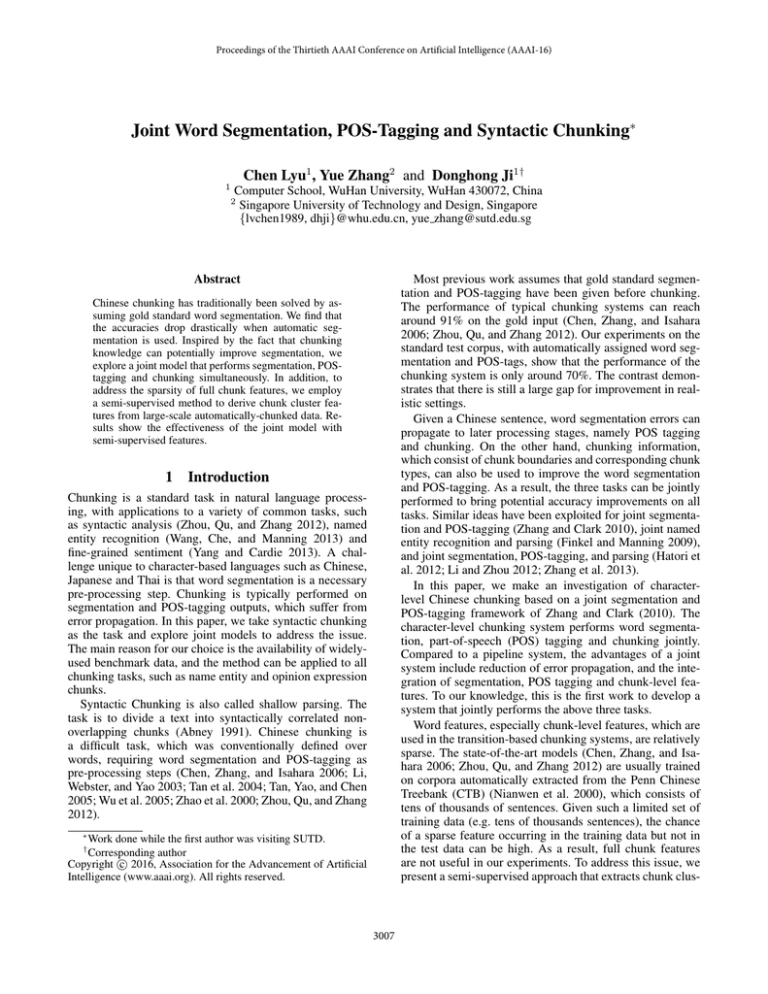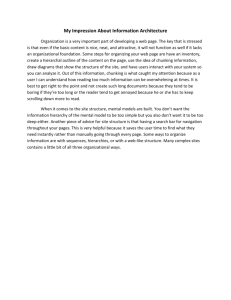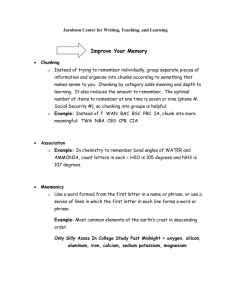
Proceedings of the Thirtieth AAAI Conference on Artificial Intelligence (AAAI-16)
Joint Word Segmentation, POS-Tagging and Syntactic Chunking∗
1
Chen Lyu1 , Yue Zhang2 and Donghong Ji1†
Computer School, WuHan University, WuHan 430072, China
Singapore University of Technology and Design, Singapore
{lvchen1989, dhji}@whu.edu.cn, yue zhang@sutd.edu.sg
2
Most previous work assumes that gold standard segmentation and POS-tagging have been given before chunking.
The performance of typical chunking systems can reach
around 91% on the gold input (Chen, Zhang, and Isahara
2006; Zhou, Qu, and Zhang 2012). Our experiments on the
standard test corpus, with automatically assigned word segmentation and POS-tags, show that the performance of the
chunking system is only around 70%. The contrast demonstrates that there is still a large gap for improvement in realistic settings.
Given a Chinese sentence, word segmentation errors can
propagate to later processing stages, namely POS tagging
and chunking. On the other hand, chunking information,
which consist of chunk boundaries and corresponding chunk
types, can also be used to improve the word segmentation
and POS-tagging. As a result, the three tasks can be jointly
performed to bring potential accuracy improvements on all
tasks. Similar ideas have been exploited for joint segmentation and POS-tagging (Zhang and Clark 2010), joint named
entity recognition and parsing (Finkel and Manning 2009),
and joint segmentation, POS-tagging, and parsing (Hatori et
al. 2012; Li and Zhou 2012; Zhang et al. 2013).
In this paper, we make an investigation of characterlevel Chinese chunking based on a joint segmentation and
POS-tagging framework of Zhang and Clark (2010). The
character-level chunking system performs word segmentation, part-of-speech (POS) tagging and chunking jointly.
Compared to a pipeline system, the advantages of a joint
system include reduction of error propagation, and the integration of segmentation, POS tagging and chunk-level features. To our knowledge, this is the first work to develop a
system that jointly performs the above three tasks.
Word features, especially chunk-level features, which are
used in the transition-based chunking systems, are relatively
sparse. The state-of-the-art models (Chen, Zhang, and Isahara 2006; Zhou, Qu, and Zhang 2012) are usually trained
on corpora automatically extracted from the Penn Chinese
Treebank (CTB) (Nianwen et al. 2000), which consists of
tens of thousands of sentences. Given such a limited set of
training data (e.g. tens of thousands sentences), the chance
of a sparse feature occurring in the training data but not in
the test data can be high. As a result, full chunk features
are not useful in our experiments. To address this issue, we
present a semi-supervised approach that extracts chunk clus-
Abstract
Chinese chunking has traditionally been solved by assuming gold standard word segmentation. We find that
the accuracies drop drastically when automatic segmentation is used. Inspired by the fact that chunking
knowledge can potentially improve segmentation, we
explore a joint model that performs segmentation, POStagging and chunking simultaneously. In addition, to
address the sparsity of full chunk features, we employ
a semi-supervised method to derive chunk cluster features from large-scale automatically-chunked data. Results show the effectiveness of the joint model with
semi-supervised features.
1
Introduction
Chunking is a standard task in natural language processing, with applications to a variety of common tasks, such
as syntactic analysis (Zhou, Qu, and Zhang 2012), named
entity recognition (Wang, Che, and Manning 2013) and
fine-grained sentiment (Yang and Cardie 2013). A challenge unique to character-based languages such as Chinese,
Japanese and Thai is that word segmentation is a necessary
pre-processing step. Chunking is typically performed on
segmentation and POS-tagging outputs, which suffer from
error propagation. In this paper, we take syntactic chunking
as the task and explore joint models to address the issue.
The main reason for our choice is the availability of widelyused benchmark data, and the method can be applied to all
chunking tasks, such as name entity and opinion expression
chunks.
Syntactic Chunking is also called shallow parsing. The
task is to divide a text into syntactically correlated nonoverlapping chunks (Abney 1991). Chinese chunking is
a difficult task, which was conventionally defined over
words, requiring word segmentation and POS-tagging as
pre-processing steps (Chen, Zhang, and Isahara 2006; Li,
Webster, and Yao 2003; Tan et al. 2004; Tan, Yao, and Chen
2005; Wu et al. 2005; Zhao et al. 2000; Zhou, Qu, and Zhang
2012).
∗
Work done while the first author was visiting SUTD.
Corresponding author
c 2016, Association for the Advancement of Artificial
Copyright Intelligence (www.aaai.org). All rights reserved.
†
3007
ter features from large automatically-chunked data to improve chunking.
Standard evaluation shows that the joint model outperforms a baseline pipeline system that consists of a joint segmentation and POS-tagging system, and a transition-based
chunker that takes segmented and POS-tagged inputs, both
components giving competitive results. In addition, semisupervised learning effectively reduces the sparsity of full
chunk features, which are not useful in fully supervised systems. Our semi-supervised chunk cluster features improve
the accuracies of both chunking and segmentation/POStagging in the joint chunking system.
2
tagging model (Zhang and Clark 2010) and a word-based
chunker. Both systems are built using the global discriminative learning for structured prediction, and beam search
framework of Zhang and Clark (2011).
3.1
We apply Zhang and Clark (2010) as the baseline word segmentation and POS-tagging system. Because the training
and decoding framework is also used for our baseline chunker and joint chunker, we give the model description and
training algorithm in details in their generic forms.
The Transition System Given an input sentence, the joint
segmentor and POS-tagger builds an output incrementally,
one character at a time. At each step, each character can either be attached to the current word or separated as the start
of a new word. When the current character starts a new word,
a POS-tag is assigned to the new word. When the character
is concatenated to a word, the POS-tag of the word remains
unchanged.
Formally, a state item in the transition system consists a
stack and a queue. The stack contains partially segmented
and tagged sentence, and the queue consists of the unprocessed character sequence. The candidate transition action
at each step is defined as follows:
Related Work
Chunking research started with English, with the CoNLL2000 offering a platform for system comparison (Sang and
Buchholz. 2000). The benchmark data was generated from
the Penn Treebank. Most previous work reduced chunking to
sequence labeling problems. Classification models, including SVMs (Kudo and Matsumoto 2001) and other classifiers (Zhang, Damerau, and Johnson 2002), have been used.
Kudo and Matsumoto (2000) applied combinations of multiple SVMs classifiers to English chunking and achieved the
best performance in the CoNLL2000 shared task. Sequence
labeling models, such as CRFs, were widely used for chunking, and gave state-of-the-art results (Sha and Pereira 2003;
Mcdonald, Crammer, and Pereira 2005).
Similar approaches, including classification models and
sequence labeling models, were also applied for Chinese
chunking (Li, Webster, and Yao 2003; Tan et al. 2004;
Tan, Yao, and Chen 2005; Wu et al. 2005; Zhao et al. 2000).
Chen, Zhang and Isahara (2006) used CTB4 as a standard
benchmark to compare the performances of several state-ofthe-art models for Chinese chunking, and proposed ensemble voting methods to improve performance.
Most previous work focused on gold segmentation and
POS-tagging input, while there are also some research exploiting the chunking systems that take input with gold segmentation and automatically assigned POS-tags (Sun et al.
2008; Yao, Li, and Huang 2007). To our knowledge, our
work is the first to perform chunking on raw text, without
assuming that the input has been assigned with gold segmentation.
In terms of features, most previous work performed
chunking with word-level features. Zhou, Qu and
Zhang (2012) utilized chunk-level features, and achieved
state-of-the-art performance. Most of their features are
based words within chunks, such as the first word and the
last of the chunk. We find that full chunk features are not
useful in our fully supervised model due to their sparseness.
Yao, Li, and Huang (2007) utilized distributional similaritybased features to solve the sparsity of word features. To our
knowledge, our semi-supervised model is the first to solve
the sparsity problem of full chunk features.
3
Joint Word Segmentation and POS-Tagging
• S EPARATE (TAG ): remove the front character from the
queue, and add it as the start of a new word with the POS
TAG on the stack.
• A PPEND: remove the front character from the queue, and
append it to the last partial word on the stack.
Given the sentence “他到达北京机场。”(He reached
Beijing airport), the sequence of actions S EPARATE (NR) S EPARATE (VV) - A PPEND - S EPARATE (NR) - A PPEND S EPARATE (NN) - A PPEND - S EPARATE (PU) can be used
to analyze its structure.
Model A linear model is used to score both partial and full
candidate outputs. Given an input x, the score of a candidate
output y is computed as:
Score(y) = Φ(y) · w
(1)
where Φ(y) is the global feature vector extracted from y, and
w
is the parameter vector of the model.
Given a partial or complete candidate y, its global feature
vector Φ(y) is extracted by instantiating all applicable feature templates for each character in y. The feature templates
are taken from Zhang and Clark (2010). Table 1 summarizes
the features, where w, t and c are used to represent a word, a
POS-tag and a character, respectively.
The subscripts are based on the current character. c0 , c−1
and c−2 represent the current character and its previous two
characters, respectively; w−1 and w−2 represent the previous two words to the current character, respectively; t0 ,
t−1 and t−2 represent the POS tags of the current word and
the previous two words, respectively. start(w), end(w) and
len(w) represent the first character, the last character and
the length of word w, respectively.
Baseline systems
We use a transition-based model for the baseline chunking
system. It consists of a joint word segmentation and POS-
3008
ID
1
2
3
4
5
6
7
8
9
10
11
12
13
14
15
16
17
18
19
20
21
22
23
24
25
26
27
28
29
Feature Templates
w−1
w−2 · w−1
w−1 , where len(w−1 ) = 1
start(w−1 ) · len(w−1 )
end(w−1 ) · len(w−1 )
end(w−1 ) · c0
c−1 · c0
start(w−1 ) · end(w−1 )
w−1 · c0
end(w−2 ) · w−1
start(w−1 ) · c0
end(w−2 ) · end(w−1 )
w−2 · len(w−1 )
len(w−2 ) · w−1
w−1 · t−1
t−1 · t0
t−2 · t−1 · t0
w−1 · t0
t−2 · w−1
w−1 · t−1 · end(w−2 )
w−1 · t−1 · c0
c−2 · c−1 · c0 · t−1 , where len(w−1 ) = 1
start(w0 ) · t0
t−1 · start(w−1 )
t0 · c0
t0 · c0 · start(w0 )
c · t−1 · end(w−1 ), where c ∈ w−1 and c = end(w−1 )
c0 · t0 · c−1 · t−1
c0 · t0 · c−1
Algorithm 1 Beam Search Decoding
Input: problem, agenda, candidates, N
Output: the highest-scored final state
1: candidates ← S TART I TEM(problem)
2: agenda ← C LEAR(agenda)
3: for loop do
4:
for s in candidates do
5:
for action in G ETACTIONS(s) do
6:
agenda ← A PPLY(s, action)
7:
end for
8:
end for
9:
best ← T OP(agenda)
10:
if G OALT EST(problem, best) then
11:
return best
12:
end if
13:
candidates ← T OP -N(agenda, N)
14:
agenda ← C LEAR(agenda)
15: end for
processed. C LEAR removes all items from the agenda.
G ETACTIONS represents all possible actions which one
candidate s can take to generate new state items, for the joint
word segmentation and POS-tagging task, G ETACTIONS returns {S EPARATE (TAG ), A PPEND}. A PPLY represents an
incremental processing step, which takes a state item s and
generates new state items from it according to the action,
and then puts new state items onto the agenda.
T OP returns the highest scoring state item on the agenda.
G OALT EST checks whether the incremental decoding process is completed; for the joint word segmentation and POStagging task, the process is completed if the state item consists of a fully segmented and tagged sentence and an empty
remaining character sequence. T OP -N returns the N-highest
scoring state items on the agenda, which are used for the
next incremental step.
Table 1: Feature templates for the joint word segmentation
and POS-tagging system (Zhang and Clark 2010).
Decoding We apply beam-search for decoding. An agenda
is used to keep the N-best partial outputs at each incremental step. Before decoding starts, the agenda is initialized with
the start state item. During the incremental process, existing
candidates are extended in all possible ways, and the N-best
newly generated candidates are used for the next incremental step. When the process is complete, the highest-scored
candidate from the agenda is taken as the output.
Pseudocode for the beam-search algorithm is given in Algorithm 1, where the variable problem represents a particular task, such as joint word segmentation and POS-tagging,
and the variable candidate represents a state item, which
has a different definition for each task. For example, for the
joint word segmentation and POS-tagging task, a candidate
is a pair, consisting of the partially segmented and tagged
sentence and the remaining input character sequence. The
agenda is an ordered list, used to keep all the state items
generated at each stage, ordered by the score. The variable
candidates is the set of state items that can be used to generate new state items, namely the N-best state items from
the previous stage. N is the number of state items retained at
each stage.
S TART I TEM initializes the start state item according to the
problem; for the joint word segmentation and POS-tagging
task, the start state item is a pair consisting of an empty sentence and the complete sequence of characters waiting to be
Training The learning algorithm is based on the generalized perceptron (Collins 2002). Parameter adjustments can
be performed at any character during the decoding process,
using the early update mechanism (Collins and Roark 2004;
Zhang and Clark 2011).
3.2
Word-based Chinese Chunking
We use the same framework as described in Section 3.1 for
the baseline word-based chunker. To our knowledge, we are
the first to report a transition-based syntactic chunker in the
literature, scoring transition action sequences instead of output sentences directly, which most previous work does.
The Transition System Similar to the joint word segmentation and POS-tagging model, the word-based chunking
model builds an output incrementally, one word at a time.
At each step, each word can either be attached to the current
chunk or separated as the start a new chunk. When the current word starts a new chunk, a chunk type is assigned to the
new chunk. When the word is concatenated to a chunk, the
chunk type of the chunk remains unchanged.
3009
• S EPARATE (T YPE ): remove the front word from the
queue, and add it as the start of a new chunk with the
label TYPE on the stack.
ID
1
2
3
4
5
6
7
8
9
10
11
12
13
14
15
16
17
18
19
20
21
22
23
24
• A PPEND: remove the front word from the queue, and append it to the last partial chunk on the stack.
25
step action
stack
queue
0
Φ
他/NR
1 S EP (NP)
[NP 他/NR]
到达/VV
2 S EP (VP) [NP 他/NR][VP 到达/VV] 北京/NR
3 S EP (NP) [NP 他/NR][VP 到达/VV] 机场/NN
[NP 北京/NR]
4 A PP (NP) [NP 他/NR][VP 到达/VV] 。/PU
[NP 北京/NR 机场/NN]
5
S EP (O) [NP 他/NR][VP 到达/VV]
Φ
[NP 北京/NR 机场/NN]
[O 。/PU]
Table 2: Word-based chunking example.
The state item in the transition system consists a stack and
a queue. The stack contains partially chunked sentence, and
the queue consists of the unprocessed word sequence. The
candidate transition action at each step is defined as follows:
26
27
28
29
30
31
32
33
34
35
36
37
38
39
40
Table 2 gives an example action sequence for the sentence “他/NR(He) 到达/VV(reached) 北京/NR(Beijing)
机场/NN(airport)。”.
The same linear model from Section 3.1 is applied to
score candidate outputs. Table 3 summarizes the feature
templates. Some templates are adapted from Zhou, Qu and
Zhang (2012). In the feature templates, C, T, w and t are used
to represent a chunk, a chunk type, a word and a POS tag,
respectively. N is the queue of incoming words. The subscripts are based on the current word. C0 and C−1 represent
the current chunk and the previous chunk, respectively. T0
and T−1 represent the chunk types of the current chunk and
the previous chunk, respectively. N0 , N1 , and N2 represent
the front items from the queue.
Label(w) represents the position of the word w in the current chunk (here refers to label ”B” and ”I” in a BI sequence
labeling tag set). Bigram(w) denotes the word to the left of w
and the one to the right of w. And the similar meaning is for
biPOS(w). POSset(C) represents the sequence of POS tags
in chunk C. start word(C), end word(C) and len(C) represent the first word, the last word, and the length of chunk C,
respectively. Similarly, start POS(C) and end POS(C) represent the POS tags of the first word and the last word in
chunk C, respectively.
The training method described in Section 3.1 is
used. For the decoding process, G ETACTIONS returns
{S EPARATE (T YPE ), A PPEND}.
4
Feature Templates
N0 w
N0 t
N1 w
N1 t
N2 w
N2 t
N 0 w · N0 t
N 1 w · N1 t
N 2 w · N2 t
N 0 w · N1 w
N 0 w · N1 t
N 0 t · N1 w
N 0 w · N1 w · N0 t
N 0 w · N1 w · N1 t
N 1 w · N2 w
N 1 w · N2 t
N 1 t · N2 w
N 1 t · N2 t
w1 · N0 · T0 , where len(C0 ) = 1
start word(C0 )T0
start P OS(C0 )T0
end word(C0 )T0
end P OS(C0 )T0
w · end word(C0 ) · T0
where w ∈ C0 and w = end word(C0 )
t · end P OS(C0 ) · T0
where t ∈ P OSset(C0 ) and p = end P OS(C0 )
w · label(w) · T0 for all w in C0
bigram(w) · label(w) · T0 for all w in C0
biP OS(w) · label(w) · T0 for all w in C0
P OSset(C0 ) · T0
T0 · T−1
end word(C−1 ) · T−1 · start word(C0 ) · T0
end word(C−1 ) · T−1 · end word(C0 ) · T0
start word(C−1 ) · T−1 · start word(C0 ) · T0
end P OS(C−1 ) · T−1 · start P OS(C0 ) · T0
end P OS(C−1 ) · T−1 · end P OS(C0 ) · T0
start P OS(C−1 ) · T−1 · start P OS(C0 ) · T0
end word(C−1 ) · T0 ; end P OS(C−1 ) · T0
T−1 · T0 · start word(C0 )
T−1 · T0 · start P OS(C0 )
P OSset(C−1 ) · T−1 · P OSset(C0 ) · T0
Table 3: Feature templates for word-based chunking.
deque between the stack and the queue to save partial segmented and POS-tagged results.
The mode use two types of transition actions, one for
joint word segmentation and POS-tagging and the other for
chunking. The joint segmentation and POS-tagging actions
operate between the deque and the queue, while the chunking actions operate between the stack and the deque. The
candidate transition action at each step is defined as follows:
• S EPARATE (TAG ): remove the front character from the
queue, and add it as the start of a new word with the POS
TAG on the deque. This action can only be applied when
the length of the deque is less than t and the last word in
the deque is a full word.
Character-Level Chinese Chunking
We develop a character-based chunking model under
transition-based framework, which jointly performs word
segmentation, POS tagging and chunking, by making a
change to the state item of the baseline chunker, adding a
• A PPENDW ORD: remove the front character from the
queue, and append it to the last partial word on the deque.
3010
step action
0
1 S EP (NR)
2
F IN W
3 S EP (NP)
4 S EP (VV)
5
A PP W
6
F IN W
...
...
15
A PP C
...
...
stack
deque queue
Φ
Φ
他 到
Φ
他/NR 到 达
Φ
他/NR 到 达
[NP 他/NR]
Φ
到 达
[NP 他/NR]
到/VV 达 北
[NP 他/NR]
到达/VV 北 京
[NP 他/NR]
到达/VV 北 京
...
...
[NP 他/NR]
Φ
。
[VP 到达/VV]
[NP 北京/NR 机场/NN]
...
...
the automatically-chunked data, and then merge the same
chunks into one entry in order to count their frequency. We
eliminate all chunks that occur only once in the data.
The extracted chunks are grouped into three sets corresponding to three levels of frequency: “high-frequency
(HF)”, “middle-frequency (MF)”, and “low-frequency
(LF)”, which correspond to chunks in the TOP-10% most
frequent chunks, the TOP-20% chunks and the other chunks,
respectively. We store the set ID for each chunk in a map
M APc . During testing, if a chunk is not included in M APc ,
its set ID is ZERO. Therefore, we have four labels: HF, MF,
LF, and ZERO for one chunk.
We generate chunk cluster features for the chunk-based
feature templates, replacing the chunk with the indicator
functions for set IDs of the retrieved chunk in the chunking
process. The set IDs are much less sparse compared to full
chunk features. We also extract word bigram list and generate bigram-based features from unlabeled data using the
same method.
To our knowledge, we are the first to apply semisupervised method of Chen et al. (2009) to a transition-based
model. When applied to a graph-based model, the mechanism of the cluster features is easy to understand, which
scores contextual patterns directly. Here we give some intuition on how it works on our transition-based model. Considering the chunk-based feature templates in the decoding
process, if C0 in the candidate is labeled as HF, the model
tends to apply the S EPARATE (T YPE ) action to the candidate, and therefore the weight of the S EPARATE (T YPE ) action should be higher in the model. In this way, the semisupervised chunk cluster features can improve the chunking
performance in the transition-based model. Similarity, semisupervised word bigram features can improve word segmentation in the transition-based model.
Table 4: Character-based chunking example.
This action can only be applied when the length of the
deque is less than t and the last word in the deque is a
partial word.
• F INISH W ORD: mark the last partial word on the deque
as a full word. The action is necessary for counting the
number of full words in the deque.
• S EPARATE (T YPE ): remove the front word from the
deque, and add it as the start of a new chunk with the
label TYPE on the stack. This action can only be applied
when the length of the deque is equal with t.
• A PPEND C HUNK: remove the front word from the deque,
and append it to the last partial chunk on the stack. This
action can only be applied when the length of the deque
is equal with t.
• F INISH: finalized the state item. This action can only be
applied when both the deque and queue are empty.
Table 4 gives an example action sequence for the sentence
“他到达北京机场。”(He reached Beijing airport).
The same linear model from Section 3.1 is applied to
score the candidate outputs. The feature templates of our
character-based chunking model contains the union of the
baseline chunking features in Table 3, and the baseline joint
word segmentation and POS tagging features in (Zhang and
Clark 2010).
The training method described in Section 3.1 is
used. For the decoding process, G ETACTIONS returns
{S EPARATE (TAG ), A PPENDW ORD, F INISH W ORD, S EPA RATE (T YPE ), A PPEND C HUNK , F INISH }.
5
5.2
Table 5 summarizes the feature templates. Similar to Table 3, C, T and w are used to represent a chunk, a chunk
type and a word, respectively. N is the queue of incoming
words. C0 and C−1 represent the current chunk and the previous chunk, respectively. T0 and T−1 represent the chunk
types of the current chunk and the previous chunk, respectively. w−1 and w−2 represent the previous two words to
the current character, respectively. N0 represents the front of
the queue. POSset(C) represents the sequence of POS tags
in chunk C. start word(C), end word(C) and len(C) represent the first word, the last word, and the length of chunk
C, respectively. None of these features are included in Table 3, because they do not give higher accuracies. All the
features all contain full chunk or word bigram information,
and therefore are highly sparse.
Semi-supervised model
In order to make use full chunk features to improve accuracies, we exploit semi-supervised learning to derive such features with less sparsity. In particular, we use our joint model
to segment, POS-tag and chunk raw text, and extract semisupervised chunk cluster features from the automaticallyanalyzed data according to the feature templates.
5.1
Feature Templates
6
6.1
Features Extraction
Experiments
Experimental Settings
Unlike English chunking, there is not a most commonly
used benchmark corpus for Chinese chunking. We follow
Chen, Zhang and Isahara (2006) in dataset selection and
We follow the method of Chen et al. (2009) for semisupervised feature extraction. First, we extract chunks from
3011
Feature Templates
C0
C 0 · T0
C0 · P OSset(C0 )
C0 , where len(C0 ) = 1
C0 · N0 w
C 0 · N 0 w · T0
C−1 · C0
T−1 · C0
C−1 · T0
C0 · end word(C−1 )
C−1 · len(C0 )
C0 · len(C−1 )
C0 · end word(C−1 ) · T 0
C−1 · T−1 · C0 · T0
w−2 · w−1
SEG
95.75
95.68
95.50
95.81
95.70
t=1
t=2
t=3
t=4
t=5
POS
92.73
92.40
92.20
92.65
92.39
ϵϬ
ϵϱ
ϵϰ
ϴϬ
ϵϯ
ϳϬ
ĐĐƵƌĂĐLJ
ϵϮ
Table 5: Additional feature templates for the semisupervised chunking model.
ϵϭ
Training
Dev
Test
Sentences
9,528
ϲϬ
ϵϬ
ϭď
Sections
1-300
326-899
301-325
900-1078
CHUNK
83.77
83.44
83.30
84.52
83.74
Table 7: The influence of deque size.
ĐĐƵƌĂĐLJ
ID
1
2
3
4
5
6
7
8
9
10
11
12
13
14
15
Words
232,085
ϭď
ϱϬ
ϰď
ϰď
ϴϵ
ϭϲď
ϭϲď
ϲϰď
ϲϰď
ϰϬ
ϴϴ
350
5,290
6,821
165,862
ϯϬ
ϴϳ
ϭ
ϱ
ϵ
ϭϯ
ϭϳ
Ϯϭ
dƌĂŝŶŝŶŐŝƚĞƌĂƚŝŽŶ
(a) Word-based.
Table 6: Statistics of the CTB4 corpus.
Ϯϱ
Ϯϵ
ϭ
ϱ
ϵ
ϭϯ
ϭϳ
Ϯϭ
Ϯϱ
Ϯϵ
dƌĂŝŶŝŶŐŝƚĞƌĂƚŝŽŶ
(b) Character-based.
Figure 1: The influence of beam size.
chunk type defination. The chunking corpus can be extracted from CTB4 with a public tool1 . We conduct our
experiments on the CTB4 corpus following previous studies on Chinese chunking (Chen, Zhang, and Isahara 2006;
Zhou, Qu, and Zhang 2012). We split the corpus according
to previous work, using files (FID from 301-325) from the
training set as the development set from the training set. Table 6 lists the details about the CTB4 data used in this experiment.
We use wikidump201503252 as the raw text for the
semi-supervised model. All the traditional Chinese pages
in Wikipedia are converted to simplified Chinese using the
tool OpenCC3 . After removing duplication, 5.3 million sentences are reserved.
We evaluated the results in the same way as the
CONLL2000 share-task, using precision P and recall R. The
F1 score is given by F 1 = 2 × P × R/(P + R).
6.2
shows the results, according to which we set t = 4 for the
character-level chunking model for the other experiments.
Influence of Beam Size We use a beam size of 16 for
joint segmentation and POS-tagging according to previous
work (Zhang and Clark 2010). Figure 1(a) shows the accuracy curves of our word-based chunking model using different beam sizes with respect to the number of training iterations. We use gold word segmentation and POS-tags in
this step. Figure 1(b) shows the accuracy curves for our
character-level chunking model using different beam sizes
with respect to the number of training iterations. We set the
beam sizes of both chunkers to 64 according to the the figures.
Comparison with Other Word-based Chinese Chunking
Models Chen, Zhang and Isahara (2006) compared the
performance of some state-of-the-art machine learning models, including SVMs, CRFs, transformation-based learning
and memory-based learning for Chinese chunking on the
CTB4 corpus. They proposed ensemble voting methods to
improve performance. We evaluate our word-based chunking model using the same dataset and compare our results
with Chen, Zhang and Isahara (2006) and Zhou, Qu and
Zhang (2012).
Table 8 shows the results. The results of CRFs-based and
SVMs-based chunking systems are taken from Chen, Zhang
and Isahara (2006). Baseline refers to our word-based chunker and Pipeline refers to our pipeline chunking model. Our
word-based chunking model give comparable results on the
Development Results
Our development tests are mainly used to decide the size of
the beam b and the deque size t in the transition system. We
set the number of training iterations to 30 for all the experiments.
Influence of Deque Size We first adjust the deque size t
for our character-level chunking model. In this step, we set
the beam size b=16 and the training iteration n=30. Table 7
1
https://github.com/rainarch/ChunkLinkCTB
http://download.wikipedia.com/zhwiki/20150325/
3
https://github.com/BYVoid/OpenCC
2
3012
Method
CRFs
SVMs
Chen, Zhang and Isahara (2006)
Zhou, Qu and Zhang (2012)
Our Baseline
Pipeline
CHUNK
90.74
91.46
91.68
92.11
91.43
69.02
Pipeline
Pipeline-C
Pipeline-Semi-C
Joint
Joint-C
Joint-Semi-C
Table 8: Results of word-based chunking.
Supervised
Semi-ALL
Semi-C
Semi-C0
Semi-W
SEG
89.85
91.00
90.67
90.71
90.72
POS
81.94
82.71
82.45
82.59
82.53
CHUNK
70.96
72.29
72.09
71.98
71.62
CHUNK
69.02
68.82
69.45
70.96
70.63
72.09
• Pipeline-C: Pipeline + feature templates 1-14 in Table 5
for the baseline chunker.
• Pipeline-Semi-C: Pipeline + templates 1-14 in Table 5
for the semi-supervised model.
• Joint: character-level chunking model, using feature templates describe in Section 4.
• Joint-C: Joint + feature templates 1-14 in Table 5 for the
joint chunker.
• Joint-Semi-C: Joint + feature templates 1-14 in Table 5
for the semi-supervised model.
same input with gold segmentation and POS-taggings.
When our word-based chunking model is applied to the
automatically segmented and POS-tagged input, the chunking performance decrease significantly. The contrast shows
the significance of segmentation errors to chunking accuracies in the realistic setting. To our knowledge, this is the first
work to evaluate a pipeline chunking system.
Table 10 shows the results of the above models on the
test data. From the table, we can see that the joint model
is better than the pipeline model on chunking performance,
and also give a higher word segmentation and POS-tagging
performance. Without using semi-supervised features, the
joint model improves the segmentation, POS-tagging and
chunking accuracies significantly (p < 10−3 ) from 88.81%,
80.64% and 69.02% to 89.85%, 81.94% and 70.96%, respectively, compared with the pipeline model.
On the other hand, full chunk features can not improve
the chunking performance in the supervised model due to its
sparsity. In contrast, when applied to the semi-supervised
model, they can improve not only the chunking performance, but also the word segmentation and POS-tagging
performance of the joint model, showing the effectiveness
of reducing feature sparsity. Compared with the joint model
without using semi-supervised features, the joint model with
all the semi-supervised model improves segmentation, POStagging and chunking accuracies significantly (p < 10−3 ).
Compared to the pipelined baseline, our best model SemiALL gives an error reduction of 19.57%, 10.69% and
10.56% on word segmentation, POS-tagging and chunking,
respectively.
Results of Semi-supervised Model
We explore the performance of semi-supervised model using
different feature templates. The models are listed below:
• Supervised: the joint model using the feature templates
describe in Section 4.
• Semi-ALL: Supervised + feature templates in Table 5.
• Semi-C: Supervised + feature templates 1-14 in Table 5.
• Semi-C0 : Supervised + feature templates 1 in Table 5.
• Semi-W: Supervised + feature templates 15 in Table 5.
Table 9 shows the results of the above models on the
test data. Chunk cluster features, especially the C0 feature,
improve the chunking performance of the semi-supervised
model. When all the semi-supervised features are applied,
the Semi-ALL system improves the chunking F-score from
70.96% to 72.29%. The results is significant at p < 10−3 by
pair-wise t-test. In addition, semi-supervised word bigram
features also improve the word segmentation performance.
6.4
POS
80.64
80.64
80.64
81.94
81.78
82.45
Table 10: Comparison between the pipeline and joint models.
Table 9: Results of the semi-supervised models.
6.3
SEG
88.81
88.81
88.81
89.85
89.83
90.67
Comparison between the pipeline and joint
models
7
Conclusions
We studied character-level Chinese chunking using the
transition-based framework, which achieved better results
compared with a pipelined baseline that performs joint segmentation and POS-tagging, before word-level chunking.
Due to the sparsity of full chunk features, they are not effective in a fully supervised model. We exploited a semisupervised method to solve the sparsity problem by leveraging large-scale automatically-chunked text. The semisupervised chunk features improved the accuracies of both
segmentation and chunking by our joint model.
We apply the semi-supervised method on the pipeline model
and the joint model, and explore the effects of the full chunk
features.
The models are listed below:
• Pipeline: a joint word segmentation and POS-tagging
model and a word-based chunker, using feature templates
in Table 1 and Table 3, respectively. For the baseline
word-based chunker, we assign automatic POS to the
training data by 10-way jackknifing.
3013
Acknowledgments
Sang, T. K., and Buchholz., S. 2000. Introduction to
the conll-2000 shared task: Chunking. In Proceedings of
Conference on Computational Natural Language Learning
Conll.
Sha, F., and Pereira, F. 2003. Shallow parsing with conditional random fields. In Proceedings of the 2003 Conference of the North American Chapter of the Association for
Computational Linguistics on Human Language Technology
- Volume 1, 213–220.
Sun, G.; Liu, Y.; Qiao, P.; and Lang, F. 2008. Chinese chunking algorithm based on cascaded conditional random fields.
In Proceedings of the 11th Joint Conference on Information
Sciences, 2509 – 2513.
Tan, Y.; Yao, T.; Chen, Q.; and Zhu, J. 2004. Chinese chunk
identification using svms plus sigmoid. In Proceedings of
IJCNLP2004, 527–536.
Tan, Y.; Yao, T.; and Chen, Q. 2005. Applying conditional
random fields to chinese shallow parsing. In Proceedings of
CICLing2005, 167–176.
Wang, M.; Che, W.; and Manning, C. D. 2013. Joint word
alignment and bilingual named entity recognition using dual
decomposition. In Proceedings of ACL, 1073–1082.
Wu, S. H.; Shih, C. W.; Wu, C. W.; Tsai, T. H.; and Hsu,
W. L. 2005. Applying maximum entropy to robust chinese
shallow parsing. In Proceedings of ROCLING2005.
Yang, B., and Cardie, C. 2013. Joint inference for finegrained opinion extraction. In Proceedings of ACL, 1640–
1649.
Yao, L.; Li, M.; and Huang, C. 2007. Improving chinese chunking with enriched statistical and morphological
knowledge. In Proceedings of IEEE NLP-KE2007, 149 –
156.
Zhang, Y., and Clark, S. 2010. A fast decoder for joint
word segmentation and pos-tagging using a single discriminative model. In Proceedings of the 2010 Conference on
Empirical Methods in Natural Language Processing, 843–
852. Stroudsburg, PA, USA: Association for Computational
Linguistics.
Zhang, Y., and Clark, S. 2011. Syntactic processing using
the generalized perceptron and beam search. Computational
Linguistics 37(1):105–151.
Zhang, M.; Zhang, Y.; Che, W.; and Liu, T. 2013. Chinese
parsing exploiting characters. In Proceedings of ACL.
Zhang, T.; Damerau, F.; and Johnson, D. 2002. Text chunking based on a generalization of winnow. The Journal of
Machine Learning Research 2:615–637.
Zhao, T.; Yang, M.; Liu, F.; Yao, J.; and Yu, H. 2000. Statistics based hybrid approach to chinese base phrase identification. In Proceedings of Second Chinese Language Processing Workshop, 73–77.
Zhou, J.; Qu, W.; and Zhang, F. 2012. Exploiting chunklevel features to improve phrase chunking. In Proceedings
of EMNLP-CONLL, 557–567. Stroudsburg, PA, USA: Association for Computational Linguistics.
We thank all reviewers for their detailed comments. This
work is supported by the National Natural Science Foundation of China (No. 61173062, 61373108, 61133012,
61202193), the Major Projects of the National Social Science Foundation of China (No. 11&ZD189), the Key Program of Natural Science Foundation of Hubei, China (Grant
No.2012FFA088), the China Scholarship Council and Singapore Ministry of Education (MOE) AcRF Tier 2 grant
T2MOE201301.
References
Abney, S. P. 1991. Parsing by chunks. In Robert C. Berwick,
Steven P. Abney, and Carol Tenny, editors, Principle-Based
Parsing, 257–278.
Chen, W.; Kazama, J.; Uchimoto, K.; and Torisawa, K.
2009. Improving dependency parsing with subtrees from
auto-parsed data. In Proceedings of EMNLP, 570–579.
Chen, W.; Zhang, Y.; and Isahara, H. 2006. An empirical
study of chinese chunking. In Proceddings of ACL, 97–104.
Collins, M., and Roark, B. 2004. Incremental parsing with
the perceptron algorithm. In Proceedings of ACL, 111–118.
Collins, M. 2002. Discriminative training methods for hidden markov models: Theory and experiments with perceptron algorithms. In Proceedings of EMNLP, 1–8.
Finkel, J. R., and Manning, C. D. 2009. Nested named entity
recognition. In Proceedings of the 2009 Conference on Empirical Methods in Natural Language Processing: Volume 1
- Volume 1, 141–150.
Hatori, J.; Matsuzaki, T.; Miyao, Y.; and Tsujii, J. 2012. Incremental joint approach to word segmentation, pos tagging,
and dependency parsing in chinese. In Proceddings of ACL,
volume 1, 1045–1053.
Kudo, T., and Matsumoto, Y. 2000. Use of support vector
learning for chunk identification. In Proceedings of CoNLL2000 and LLL-2000, 142–144.
Kudo, T., and Matsumoto, Y. 2001. Chunking with support
vector machines. Journal of Natural Language Processing
9(107):3–21.
Li, Z., and Zhou, G. 2012. Unified dependency parsing of
chinese morphological and syntactic structures. In Proceedings of the 2012 Joint Conference on Empirical Methods in
Natural Language Processing and Computational Natural
Language Learning, 1445–1454. Stroudsburg, PA, USA:
Association for Computational Linguistics.
Li, H.; Webster, J. J.; and Yao, T. 2003. Transductive hmm
based chinese text chunking. In Proceedings of IEEE NLPKE2003, 257–262.
Mcdonald, R.; Crammer, K.; and Pereira, F. 2005. Flexible
text segmentation with structured multilabel classification.
In In Proceddings of HLT-EMNLP, 987–994.
Nianwen, X.; Fei, X.; Shizhe, H.; and Anthony, K. 2000.
The bracketing guidelines for the penn chinese treebank.
Technical report, University of Pennsylvania.
3014






